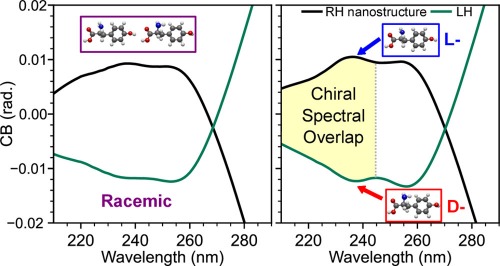LSU-Led Research Shows that Ultraviolet Metasurfaces Can Discriminate the Handedness of Biomolecules at Attomolar Concentrations
October 3, 2022
 BATON ROUGE, LA – Researchers at LSU, in collaboration with Zuse Institute in Berlin,
Germany, have developed an ultraviolet metasurface that discriminates between left-
and right-handed amino acids with attomolar sensitivity.
BATON ROUGE, LA – Researchers at LSU, in collaboration with Zuse Institute in Berlin,
Germany, have developed an ultraviolet metasurface that discriminates between left-
and right-handed amino acids with attomolar sensitivity.
That work was just published in Nano Letters and titled, “Resonant Plasmonic-Biomolecular Chiral Interactions in the Far-Ultraviolet: Enantiomeric Discrimination of Sub 10nm Amino Acid Films.”
“Detecting the handedness of dilute concentrations of biomolecules is a key step towards the early detection of many neurodegenerative disorders such as Alzheimer’s, Huntington’s, or Parkinson’s disease,” said LSU Chemical Engineering Associate Professor Kevin McPeak, lead author on the paper.
“What is unique about our work is that we developed an aluminum metasurface with chiroptical resonances that overlap with the bio-chiral signal. Developing metasurfaces with ultraviolet chiral response in resonance with biomolecular chirality is critical to maximizing the signal enhancement of weak biomolecular activity.”
Resonant plasmonic-molecular chiral interactions are a promising route to enhanced biosensing, the group writes. However, biomolecular optical activity primarily exists in the far-ultraviolet regime, posing significant challenges for spectral overlap with current metasurfaces. The group developed an optical model of a chiral biomolecular film on a plasmonic metasurface. The model showed that detectable enhancements in the chiroptical signals from the biomolecules were only possible when tight spectral overlap exists between the plasmonic and biomolecular chiral responses.
“Chiral objects are those whose mirror image is not superimposable,” McPeak said. “Your hands are a good example of this. Biomolecules, such as amino acids and proteins, which govern much of the biological processes in our bodies, are chiral as well. Light can also be chiral through polarization. Chiral-chiral interactions can be thought of as handshaking, i.e., shaking two right hands works, whereas shaking right hand to left hand can lead to some awkward moments.
“Thus, chiral biomolecules absorb chiral light in a way that lets us understand the structure of the molecules. The problem is that this is a very weak effect, and therefore, we miss much information. But metasurfaces with chiral resonances in the same wavelength regime as the biomolecular chiral response (e.g., far-ultraviolet) can amplify the weak, chiral biological signals. By tuning the plasmonic chiral response into the far-ultraviolet regime, where biomolecules have their chiral response, we maximize the potential signal enhancement and bring them into resonance.”
McPeak’s co-authors on the paper are Tiago Ramos Leite, also in the LSU Gordon and Mary Cain Department of Chemical Engineering; Orhan Kizilkaya, with the LSU Center for Advanced Microstructures and Devices; and Lin Zschiedrich, with the Zuse Institute in Berlin, Germany. The work was funded by the National Science Foundation.
To read the full paper, click here.
Like us on Facebook (@lsuengineering) or follow us on Twitter and Instagram (@lsuengineering).
###
Contact: Joshua Duplechain
Director of Communications
225-578-5706
josh@lsu.edu